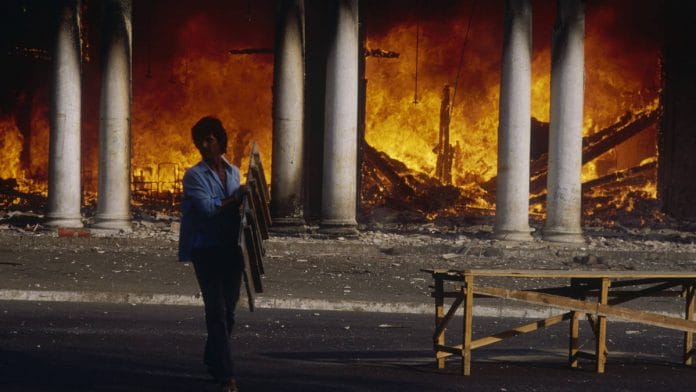A Delhi court has convicted two persons for killing two men here during the 1984 anti-Sikh riots.
New Delhi: From calling witnesses from Italy to testify in the 1984 anti-Sikh riot case to publishing public notices, the SIT, formed in 2015, took extensive measures to probe the 60 cases it had reopened out of the total 293, and succeeded in getting conviction in the first case on Wednesday.
A Delhi court Wednesday convicted two persons for killing two men here during the 1984 anti-Sikh riots.
Of the 650 cases registered in connection with anti-Sikh riots in Delhi, 267 were closed as untraced by the Delhi Police. Of these 267 cases, five were later taken up by the CBI. The SIT also scrutinised the records of 18 cancelled cases.
The SIT found 60 cases appropriate for further investigation. It filed “untraced report” in 52 cases in the last one-and-a-half years.
Out of the eight cases being investigated, charge sheets have been filed in five and three, in which senior Congress leader Sajjan Kumar is an accused, are pending investigation.
Additional Sessions Judge Ajay Pandey held Naresh Sherawat and Yashpal Singh guilty of killing Hardev Singh and Avtar Singh in theMahipalpur area of South Delhi during the riots on Wednesday.
The case was lodged on a complaint filed by Santokh Singh, brother of Hardev Singh.
On November 1, 1984, Hardev Singh, Kuldeep Singh and Sangat Singh were present at their grocery shops in Mahipalpur when a violent mob of 800-1,000 people armed with deadly weapons like iron rods, lathis, hockey sticks, stones, kerosene oil, came towards their shops.
They closed their shops and rushed to the rented accommodation of one Surjeet Singh located on the first floor of a house in the area. After some time, they were joined by Avtar Singh, who also took shelter with them. They locked themsleves inide the room.
After burning the shops, the mob came to Surjeet’s room and brutally assaulted everyone. They stabbed Hardev and Sangat and threw all the men from the balcony.
The accused poured kerosene in the room and burnt it down. The injured men were shifted to Safdarjung Hospital where Avatar Singh and Hardev Singh died and the other three underwent treatment for grievous injuries.
The Delhi Police had closed the case in 1994 for want of evidence. However, a Special Investigation Team (SIT) on the riots further investigated the case.
A case was registered at Vasant Kunj police station in 1993 on the recommendation of Justice JD Jain and DK Aggarwal committee based on the affidavit filed by Santokh Singh on September 9, 1985 before Justice Rangnath Misra Commission and the investigation was conducted by the Anti-Riot Cell of the Delhi Police.
During investigation, the Delhi Police could not gather evidence to prosecute any accused and after investigation, an untraced (closure) report was filed which was accepted by the court on February 9, 1994.
Earlier, the incident was investigated in 1984 and a charge sheet was filed in 1985 against one Jai Pal Singh but he was acquitted on December 20, 1986.
A special investigation team was formed by an order of the Ministry Of Home Affairs for investigating/re-investigating the “appropriately serious cases” of 1984 Sikh riots, which had since been closed.
The SIT was contacted by Sangat Singh, one of the victims, after they published public notices in various papers in Delhi and Punjab and subsequently, they zeroed down on Naresh Sherawat and Yashpal Singh.
Sherawat used to work in Mahipalpur post office as postmaster and Yashpal Singh, a transporter, were members of the mob involved in the attack. The SIT, in its charge sheet filed on January 31, 2017 had named them and said Sherawat had poured the kerosene oil on the door of the room where the victims were hiding.
The SIT also examined Ratan Singh, brother of Avtar Singh, who had settled in Italy. Ratan Singh came down to India in October last year to record his statement since he was the one who had identified his brother’s body at the hospital after the incident.
The case which saw conviction on Wednesday saw the SIT citing 18 witnesses in their charge sheet.
The court held both the accused guilty under various sections including 302 (murder), 307 (attempt to murder), 395 (dacoity) and 324 (voluntarily causing hurt by dangerous weapons or means) of the Indian Penal Code.
Both the convicts were taken into custody after the judgment.
The court is scheduled to hear arguments on the quantum of sentence Thursday where the convicts may get a maximum punishment of death sentence and minimum punishment of life imprisonment.
After the SIT began investigation, it published a public notice on August 27, 2016 in leading newspapers of Punjab and Delhi requesting people acquainted with the facts of the case to give evidence about it.
The SIT also found witnesses in different cases and even sought help from the Punjab government which formed a team to help the SIT trace witnesses. – PTI







Justice delayed is justice denied, goes the well-known adage. Convicting two men for killing two other men 34 years later in an incident where almost a thousand people were killed and many more injured and even higher number of people looted, is more ironical than restorative of faith in the system. Surely the judicial system can find a way to shed the sloth in the system.